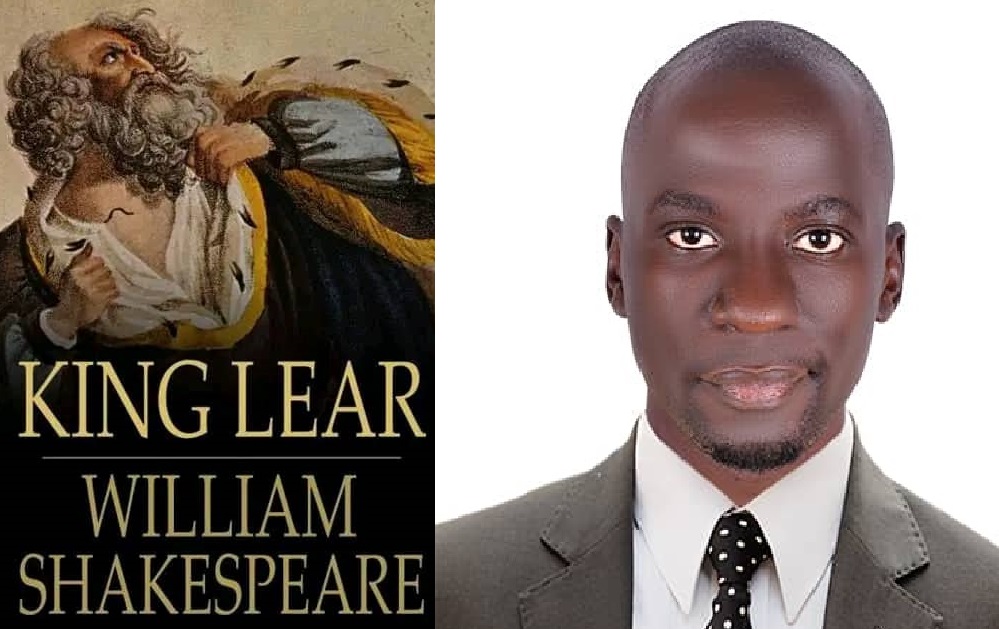TITLE: KING LEAR
AUTHOR: WILLIAM SHAKESPEARE
REVIEWER: Mubiru George
REVIEW: (part two)
LITERALLY ELEMENTS & CRITICISM
“King Lear” by William Shakespeare is a complex and rich play that explores the use of different linguistic power and devices. Here are some of the prominent literary elements found in “King Lear”:
Tragedy: “King Lear” is categorized as a tragedy, following the downfall of the main character, King Lear himself. Tragedies typically involve the protagonist’s fatal flaw, in this case, Lear’s pride and inability to see beyond his own ego.
Foreshadowing: Shakespeare makes use of foreshadowing throughout the play to hint at future events. For example, the storm that occurs on the heath is a foreshadowing of the chaos and turmoil that will unfold within the characters’ lives.
Dramatic Irony: There are instances of dramatic irony in “King Lear” where the audience knows more about the situation than the characters themselves. For instance, the audience knows that Cordelia loves her father despite Lear’s misunderstanding and rejection of her.
Imagery: Shakespeare employs vivid and powerful imagery in “King Lear” to enhance the emotional impact of the play. Examples include the storm, which symbolizes the chaos and disorder within the kingdom and Lear’s own mind.
Symbolism: There are several symbols used in the play, such as the storm, the Fool, and the blinding of Gloucester. These symbols represent larger ideas and themes, such as the destructive forces of nature and the loss of sight and insight.
Parallelism: Shakespeare often uses parallelism in “King Lear” to draw comparisons between different characters or situations. For example, the parallel stories of Lear and Gloucester both highlight the consequences of poor judgment and the betrayal of family members.
Soliloquy: Several characters in “King Lear” deliver soliloquies, where they express their inner thoughts and emotions directly to the audience. These soliloquies provide insights into the characters’ motivations and inner turmoil.
Irony: Irony is prevalent in “King Lear,” often serving to highlight the tragic and ironic nature of events. For example, Lear’s decision to divide his kingdom among his daughters based on their flattery leads to his own downfall.
Allusion: Shakespeare includes allusions to mythology and classical literature in “King Lear.” For instance, references to the gods and fate evoke a sense of a larger cosmic order that governs the events of the play.
These are just a few examples of the literary elements found in “King Lear.” Shakespeare’s play is renowned for its complexity and depth, and further analysis can reveal many more intricacies within the text.
CRITICISM
“King Lear” is one of William Shakespeare’s most celebrated plays, but it has also received its fair share of criticism. Some of the main points of criticism directed towards “King Lear” include:
Complexity of the Plot: One of the major criticisms of “King Lear” is the complexity of its plot. The play incorporates multiple storylines and a large number of characters, which can sometimes be overwhelming for audiences. The intricate plot can make it challenging for some viewers to fully grasp the intricacies of the story and the motivations of the characters.
Lack of Sympathetic Characters: Another criticism often directed towards “King Lear” is the lack of sympathetic characters. Many of the characters in the play are flawed, morally ambiguous, or driven by self-interest. This can make it difficult for audiences to fully connect with or empathize with the characters, which can impact their overall enjoyment of the play.
The Treatment of Women: Some critics argue that “King Lear” presents a negative portrayal of women. The female characters in the play, such as Lear’s daughters Goneril and Regan, are often depicted as power-hungry and manipulative. Critics argue that this portrayal perpetuates negative stereotypes about women and fails to provide nuanced and diverse representations of female characters.
Extreme Violence and Cruelty: “King Lear” is known for its brutal and violent scenes, particularly in the later acts. The blinding of Gloucester and the off-stage murders of Lear’s loyal allies are among the graphic moments that critics have pointed out. Some argue that the excessive violence can overshadow the play’s deeper themes and detract from the overall experience.
Lack of Comic Relief: Unlike many of Shakespeare’s other plays, “King Lear” lacks significant moments of comic relief. The play is predominantly tragic and lacks humorous interludes that can provide a necessary contrast and balance to other works. Some critics argue that this absence of humor can make the play emotionally exhausting and diminish its overall impact.
Ambiguity and Lack of Closure: “King Lear” ends with a high degree of ambiguity and lack of closure. The fate of several characters is left uncertain, and there is no clear resolution to many of the conflicts. While this open-endedness can provoke thought and discussion, some critics find it unsatisfying and feel that it leaves too much unresolved.
It is important to note that while “King Lear” has faced criticism, it is also widely regarded as a powerful and enduring tragedy that delves into profound themes of power, madness, family, and loyalty. Different interpretations and perspectives on the play have contributed to its ongoing significance in the realm of literature and theatre.
Do you have a story or an opinion to share? Email us on: dailyexpressug@gmail.com Or follow the Daily Express on X Platform or WhatsApp for the latest updates.
The reviewer, Mubiru George, is a Jinja-based teacher and researcher. Tel: 0754877595 or Email: georgemubiru93@gmail.com

